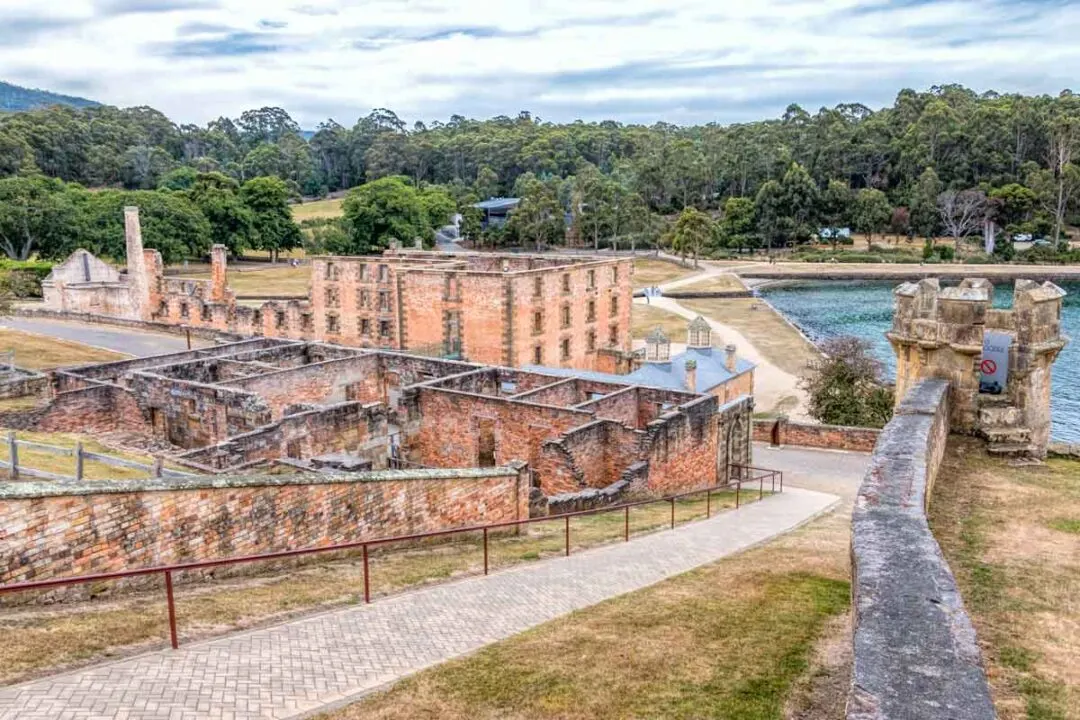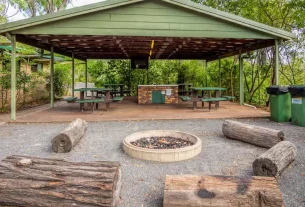The UNESCO World Heritage Port Arthur convict site is an essential part of a visit to Tasmania. Not only does it bring to life a significant time in Australian history but the dramatic scenery makes it a day trip that should not be missed.

When we found ourselves in Hobart over the long weekend we knew it would be the perfect opportunity for a visit to Port Arthur on the Tasman Peninsula to immerse ourselves in the destination, its rugged scenery and history.
Spending time in the area? Don’t miss our guide to Hobart and the many things to see and do.
Table of Contents
History of the Port Arthur Convict Site
The penal colony at Port Arthur was established in 1830 and remained in operation until 1877. Prisoners were sent from the UK and Ireland by ship to Australia, their crimes that ranged from stealing a loaf of bread to murder. Many of those convicts ended up at Port Arthur, the largest of the Australian penal sites.
Port Arthur was chosen for its timber. Even today you can appreciate the impressive backdrop of a seemingly never-ending forestry resource across the rolling landscape. Early convicts felled and milled the surrounding trees for various government projects.
Then in 1833, Port Arthur became a punishment station for repeat offenders where convicts were sent from other Australian convict sites. It was at the time a radical new design for a prison combining extreme discipline and punishment with religious and moral training.
a machine for grinding rogues into honest men

By its peak in 1840, there were more than 2000 people living at Port Arthur including convicts, soldiers and civil staff. It no longer relied on forestry alone to sustain it; worked stone, bricks, furniture, clothing, boats and ships were all produced on-site.
In 1853 when transportation of convicts to the region ended the inmates were increasing made up of those who were aged or physically and mentally ill until it finally closed in 1877.

At that time many buildings were dismantled and the small town was renamed Carnarvon in an attempt to remove itself from its convict past but the draw of its history was soon recognized and the name Port Arthur was reclaimed.
Exploring the Port Arthur Unesco World Heritage Site
The Australian Convict Sites is a Unesco listed World Heritage property made up of 11 historic sites, of these 5 are in Tasmania including:
- Port Arthur
- The coal mines
- Woolmers Estate and Brickendon
- Cascades Female Factory, and
- Darlington Probation Station on Maria Island

The Port Arthur site is so much larger and more complete than I would have expected. It is made up of 30 heritage buildings and many ruins set on 40 hectares of manicured lawns and gardens. The site was more than a prison, it was an entire community and much as that has been preserved. Make sure you wear good walking shoes as you are going to cover some distance getting around even if you restrict yourself to the key central sites.

The cruise out into the harbour, around the Isle of the Dead and the Point Puer boys prison is included in your entry fee. Make sure you hold onto your ticket that shows your allocated departure time, you don’t want to miss this. It only takes around 20 minutes but it really is impressive to see the site from the water and how dauntingly remote the site would have been for prisoners arriving here.
Visitors Centre
On your arrival, the place to start is the new visitors centre. This is where you buy tickets or check-in if you pre-purchased tickets. It also has facilities including toilets, the Port Cafe and a gift shop.
There is an information centre that includes a diorama of the site layout and another interesting feature that adds a personal story element to your visit. You will receive a playing card with your ticket then just around the corner, you’ll come to an area with many interesting drawers reminiscent of an old library with similar cards pinned to the front of each one. You take your card, carefully find the matching drawer as many are very similar and pull it out to learn who your personal inmate was.

I was following the life of James Travis, a 17-year-old Labourer from Manchester in England. He was convicted in October of 1833 for stealing 10 corsets and sentenced to 7 years of transportation, goodness only knows what a man of that age needed with so many corsets but he was moved to Port Arthur for refusing to do any sort of work.
At Pint Puer, the boys prison he refused to go to school and was locked in his cell with a book which he threw in the fire, he was then sent to Port Arthur and put to work with the men.
After a look around this area and orientating yourself your next stop is right outside, the meeting place for the introductory tour which is included in your ticket price. We did this right at the start and would recommend that approach, they start regularly and give a framework for the rest of your day.
The Penitentiary
The ruins of the penitentiary dominate the view across the massive lawns and bay. Originally built as a flour mill and store the building was converted to accommodate the increasing number of prisoners arriving.

The more problematic among them were housed in 136 cells on the 2 lower floors, the 3rd floor was the dining space and library while as many as 480 lower-risk prisoners were crammed into bunks in the dormitory-style top floor. In such cramped conditions with basic hygiene provisions it’s hardly surprising that disease spread rapidly.
The Separate Prison
Our tour ended just down the hill from here making it the logical starting point for our own exploration. This section of the site contains the Separate Prison, Asylum and Paupers Depot and was possibly the most disturbing of the whole ‘model prison’ experiment.
The Separate Prison was added as a whole new method of punishment and reform. When physical punishment failed inmates were moved here and subjected to 23 hours a day in a tiny single soundproof cell, prisoners weren’t allowed to speak, were stripped of their identity and were known only as a number.
They had one hour a day of solitary exercise in a walled yard. The psychological punishment took its toll on the mental health of those exposed to the regime, a sizable asylum was built right next door, many never recovered from their confinement and ended their days there.
The Church
The impressive church at Port Arthur served both the free community and prisoners. Up to 200 free settlers entered through the main entrance each week under the three-tiered pulpit. They worshiped in an area screened from the prisoners who entered from the side doors. In total a congregation of up to 1000 could be accommodated in one service.

The church was both a pivotal part of the rehabilitation process and yet another source of conflict. Initially, it was presided over by Weslayan Methodist ministers and later Reverend Durham of the Church of England was appointed. That created ruptions with the Catholic prisoners who then refused to attend services. Perhaps not surprisingly given the inability of the church authorities, let alone the congregation, to agree, the church was never consecrated.
Getting to the Port Arthur Convict site
Self Drive
If you have the option to self-drive I would seriously consider spending a night down in Port Arthur. Your ticket covers 2 consecutive days of entry and although we gave our best shot at seeing as much as we could in a day we could easily have spent much longer here, it’s a massive site, it wasn’t just the prison but an entire community is preserved here.
While in Port Arthur there are some other activities to enjoy too. You can explore the rugged coastal scenery or take a wilderness tour with Pennicott Journeys, we did their gourmet Bruny Island tour and will be going on one of their scenic wildlife tours next time we get down to Tasmania. You can also visit the coal mines historic site which is about 25 minutes away near Saltwater River, entry to that site is free.
Tour Port Arthur convict site from Hobart
We were in Hobart for a relatively short stay and had plans in and around the city for a good part of it so we hadn’t planned to hire a car for the full stay and when I tried to book one for a single day that turned out to not be an easy thing to do in Hobart.
Instead, we booked onto the Grayline Port Arthur tour through Get Your Guide, both the booking process and the tour itself were perfect for us. It included comfortable transport with commentary from Hobart and back, the pre-booked tickets for entry including the Port Arthur walking tour and cruise while you were there and a couple of scenic stops along the way.

We don’t usually take organised tours because we often feel rushed through the parts we want to explore and spend too much time on gift shops and things that don’t interest us as much. That is where this tour was a perfect balance.
The drive to and from Port Arthur is around 90 minutes, along the way there is an extensive and interesting commentary on Hobart, the areas we passed through along the way and Port Arthur itself as we got closer. There was a brief stop in the historic town of Richmond and to grab a coffee and short bathroom break beside the Denison Canal at Dunalley.

When we arrived at the Port Arthur Convict site the coach stopped outside the door and we were allocated our various tickets and lanyard that you need to wear on site throughout the day. We were then taken inside by our guide for an initial orientation and introduction with suggestions on getting the most out of the day but you are free to do as much as you want at your own speed.
From here you can join a walking tour with a guide from the site which is included in your ticket price. Our guide was Jett and he was amazing, he truly brought the sites history to life providing us with a mental sketch of the areas we wanted to return to and explore in detail throughout the day and a context to view it through. I would highly recommend doing the tour and getting on one as early in the day as possible.

It’s a huge site and you’ll need that framework if you want to cover most of the site including the cruise. It’s a lot of walking so your guide will also be able to suggest the most efficient way if you feel time or mobility may be a limitation.
The only other structured activity on site is your cruise time which needs to be booked in at the start but is part of your ticket price. While it might feel tempting to skip it as you are making your way down from the hill to the wharf at more of a jog than a walk but you’ll want to make sure you don’t miss it, it was a highlight of the day for us.
You can find out more about the Port Arthur tour here.
If you found this article useful please consider saving it to Pinterest. It makes it easy for you to find it again, it helps us, and it helps other travellers to find the information they are looking for.






